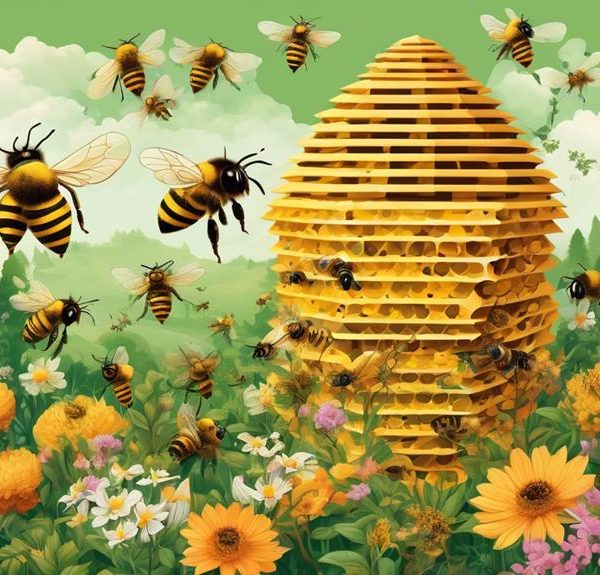Discover the intriguing reasons behind the traditional white color of bee hive boxes, and how it affects our buzzing friends' behavior.
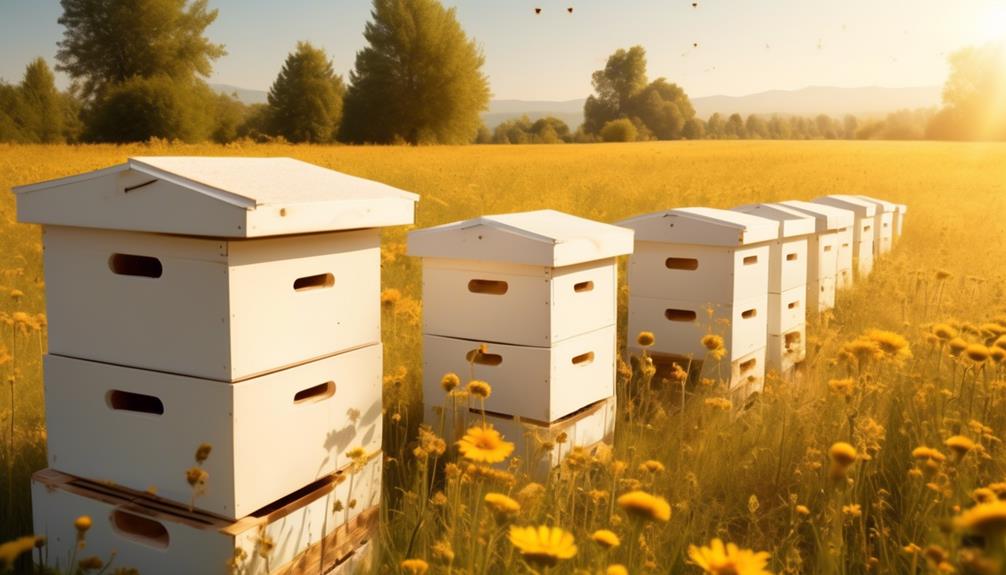
Why Are Bee Hive Boxes White
You've probably noticed that bee hive boxes are typically painted white, but have you ever stopped to consider why?
The truth behind this common practice isn't as arbitrary as it may first appear. In fact, the color choice has a lot to do with the bees themselves and their natural behavior. It's a fascinating exploration into the world of bees and how even subtle human intervention can significantly impact their lives.
But it's not just about the bees; there's more to this story that might make you see these unassuming white boxes in a whole new light.
Key Takeaways
- Bees prefer cooler temperatures and need to maintain a consistent internal hive temperature.
- White hive boxes reflect sunlight and reduce heat absorption, keeping the hive cooler.
- White is the most efficient color in reflecting sunlight and providing insulation compared to other light colors.
- Commercial beekeepers often choose white for hive boxes because of its benefits in maintaining hive temperature and productivity.
Understanding Bee Behavior

Ever wondered why bees behave the way they do in their white hive boxes? It's all down to their sophisticated social structure and keen survival instincts.
Bees, especially honeybees, are incredibly social creatures. They live in colonies that function as a single unit, with each bee playing a specific role in the hive's survival. Yes, you're right, much like a well-oiled machine. The queen, workers, and drones each have their jobs, and they perform them diligently.
Now, you're probably wondering, why white hive boxes? It's not a random choice. Bees prefer cooler temperatures, and white reflects heat better than darker colors. This way, the hive stays cooler in the summer months, and the bees can go about their business without the risk of overheating.
Understanding bee behavior is an essential aspect of beekeeping. You can't just put them in a box and expect honey. It requires careful observation and attention to detail. By knowing why they prefer white hive boxes, you can create a more comfortable and productive environment for your bees.
There you have it – a peek into the fascinating world of bees and their white abodes.
Impact of Color on Temperature
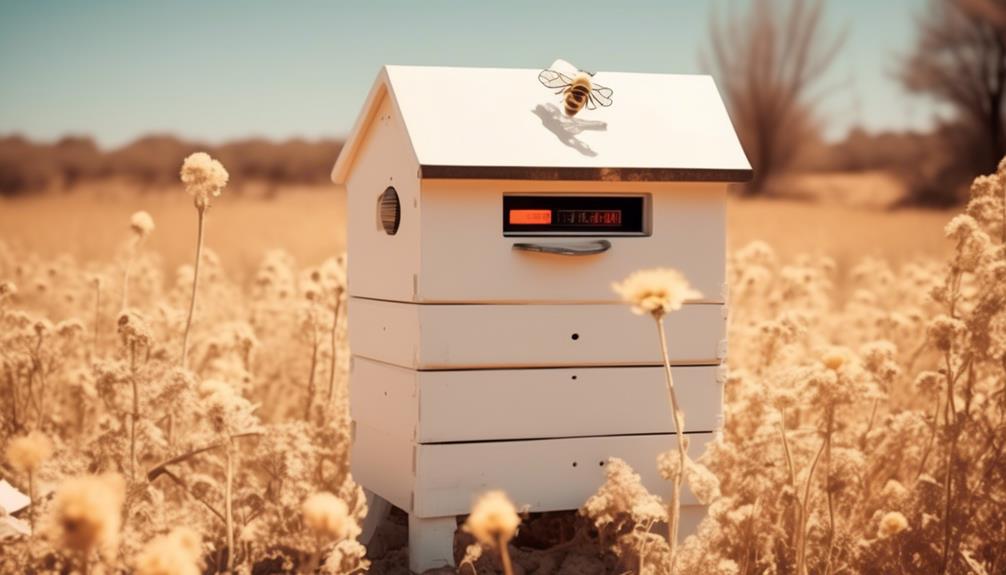
Diving deeper into the world of colors and temperature, you'll find that the color of an object, such as a bee hive box, can significantly affect its heat absorption and retention. Lighter colors, like white, reflect more sunlight and thus absorb less heat. In contrast, darker colors absorb more sunlight and heat.
If a bee hive box is painted a dark color, it absorbs more heat. This could lead to internal temperatures that are too high for the bees' comfort. High temperatures can cause bees to spend more energy on cooling the hive, which could hurt their productivity.
In contrast, a white hive box reflects sunlight, keeping internal temperatures lower. This doesn't mean the hive will be cold, rather, it ensures the hive doesn't overheat. This contributes to a more comfortable living environment for the bees, allowing them to focus on honey production instead of temperature regulation.
Why White for Bee Hive Boxes?

So, why are bee hive boxes often painted white? The answer lies in the color's natural properties. White reflects sunlight, reducing heat absorption and keeping the hive cooler in the summer. This is vital as bees need to maintain a consistent internal hive temperature to survive and thrive.
You might be wondering, 'If white is so beneficial, why not use other light colors?' Well, while other light shades also reflect sunlight, white outperforms them all. It's more efficient in reflecting sunlight and thus provides the best insulation. That's why you'll see most commercial beekeepers sticking with white.
Now, you don't have to limit yourself to white. Depending on your local climate, other colors could be suitable. For instance, in cooler regions, darker colors that absorb heat might be more beneficial. But for areas with intense summer heat, white is undoubtedly the best choice.
Other Colors and Their Effects
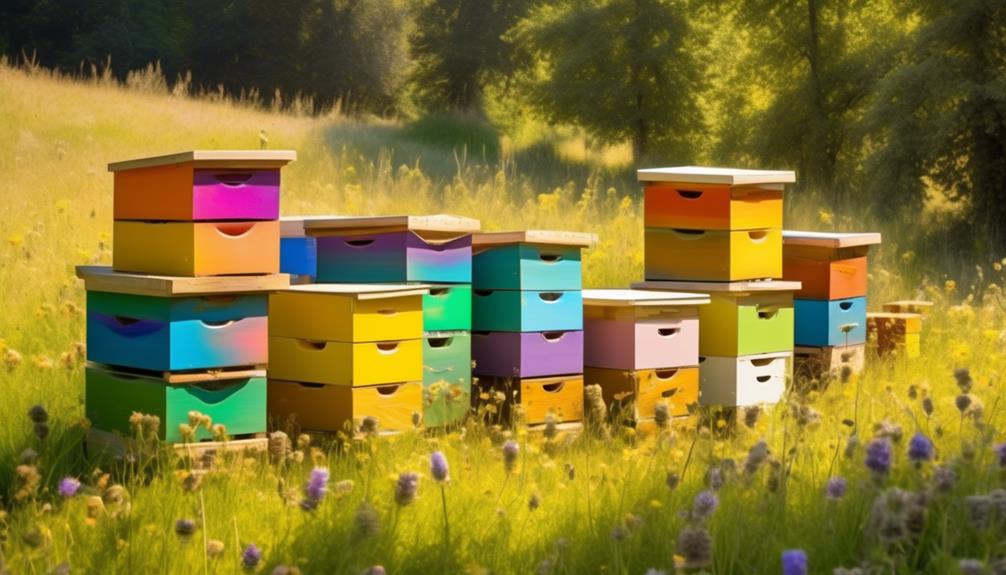
While white is the go-to color for many beekeepers, it's worth exploring how other hues might impact a hive's health and productivity. Some beekeepers opt for lighter shades like yellow or green, which, like white, reflect sunlight and help keep the hive cool. Darker colors, like black or brown, absorb heat, potentially overheating the bees on hot summer days.
However, color isn't just about temperature control. Bees perceive colors differently from humans. For instance, they can't see red but can see ultraviolet. So, a red hive might appear black to them, while a blue or purple one could be more appealing. This could potentially influence hive activity, although more research is needed in this area.
Still, it's important to remember that a hive's color won't make or break your beekeeping success. The hive's location, the availability of food and water, and the overall care you provide are far more critical. So, while it's interesting to ponder how different colors might affect your bees, don't lose sight of the bigger picture.
After all, bees have thrived in nature long before we started painting their homes.
Advantages of White Bee Hives
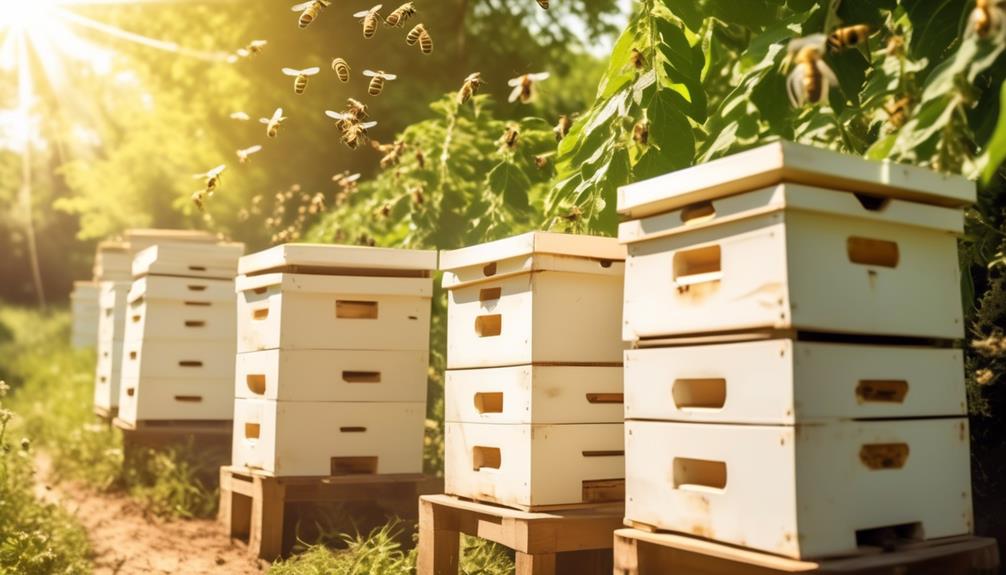
In beekeeping, choosing white for your hive boxes offers several advantages worth considering. First, white hives reflect sunlight, reducing heat absorption and keeping the hive cooler in the summer. This is crucial for the colony's survival as bees can't tolerate high temperatures and can even die if the hive overheats.
Secondly, white is a neutral color that doesn't attract predators or pests. Darker colors can attract bears and other animals, which can damage or destroy the hive.
Thirdly, white hives are easier to spot, especially in dense vegetation or at night. This makes hive management and regular inspections less challenging for you.
Lastly, painting your hives white can help protect the wood from weathering and decay. The paint acts as a barrier against moisture, which can lead to rot and shorten the lifespan of your hives.
Frequently Asked Questions
How Much Does It Cost to Maintain a White Bee Hive Box?
Maintaining a white bee hive box isn't too costly. You'll need to factor in the cost of paint to keep it white, which is around $20-$30 per gallon.
Add in periodic maintenance like replacing worn parts or treating for pests. That could add another $50-$100 annually.
So, you're looking at an initial investment of $70-$130, plus a smaller amount each year for upkeep.
Can You Use Any Type of Paint for a Bee Hive Box?
You can't use just any type of paint for a bee hive box. It's crucial to choose non-toxic, water-based paints that won't harm the bees. Avoid dark colors as they absorb heat, which can overheat the hive.
Light shades, especially white, reflect sunlight, keeping the hive cool. Don't paint inside the box; bees prefer an untreated interior.
Always prioritize the health and comfort of your bees when selecting and applying paint.
How Often Should a Bee Hive Box Be Repainted?
You should consider repainting your bee hive box every 2 to 3 years.
It's not just about aesthetics, it's about protection. Paint forms a shield against weather elements that can damage the wood.
However, don't overdo it. Too much paint can seal in moisture, leading to mold and rot.
Stick to a regular schedule and your bees will thank you for it.
Are There Any Negative Effects on Bees if a Different Color Is Used for the Hive Box?
Yes, there can be negative effects if you use a different color for the hive box. Bees are sensitive to colors and prefer lighter shades, like white.
Darker colors absorb more heat, making the hive too warm for the bees.
Also, bees may become disoriented if their hive's color is similar to surrounding hives.
Is There a Specific Type or Brand of White Paint That Works Best for Bee Hive Boxes?
You're asking about the best type of white paint for bee hive boxes.
There's no specific brand that's universally recommended. However, it's crucial to use a paint that's non-toxic to bees.
Look for exterior-grade latex paints, they're often used because they're durable and safe for bees.
Always allow ample drying time before introducing bees to a freshly painted hive.
Conclusion
So, why are bee hive boxes typically white?
It's all about temperature control and bee behavior.
Dark colors absorb heat, potentially overheating the hive, while white reflects it, keeping the interior cool.
Although other colors can be used, white remains the safest bet.
It's a simple, practical decision that can make a big difference in bee health and honey production.
Remember, when it comes to beekeeping, every small detail counts.


